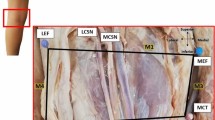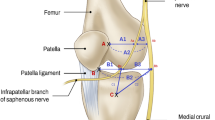Abstract
Purpose
The purpose of this study was to investigate the relationship between the proximity of neural structures to standard posterior portals in different knee positions.
Methods
Ten fresh cadaveric knees were used to establish the standard posteromedial and posterolateral portals using an outside-in technique with arthroscopic transillumination. The distance from each portal site to the adjacent neurovascular structures (infrapatellar branches of the saphenous nerve) and the sartorial branch of saphenous nerve from the posteromedial portal, and the common peroneal nerve from posterolateral portal was measured using a precision caliper. Distances were recorded with the knees in extension, 45° of flexion and 90° of flexion in order to examine the effect of dynamic knee motion on nerve position.
Results
The mean distance between the posteromedial portal and the superior and inferior branches of infrapatellar branches of the saphenous nerve at full extension was significantly greater than at 90° of flexion. However, there was no difference observed between at 45° and at 90° of flexion. The mean distance from the posteromedial portal to the sartorial branch of saphenous nerve at 90° of flexion was significantly greater (26.1 mm, SD: 4.7) than that at 45° of flexion (18.4 mm, SD: 4.6), and at full extension (14 mm, SD: 4.3) (P < 0.0001). The mean distance between the posterolateral portal to the common peroneal nerve at 90° of flexion was also significantly greater (25.4 mm, SD: 9.2) than that at 45° of flexion (22.5 mm, SD: 8.1), and at full extension (20.1 mm, SD: 9.1) (P < 0.0001).
Conclusion
In this cadaveric study, it shows that position of 90° knee flexion is reasonably safe, in order to establish a posterior portal in knee arthroscopy using the technique described in the current study, especially to avoid the sartorial branch of saphenous nerve and the common peroneal nerve injuries. Results of this study suggest the establishment of posterior portals, while the knee is flexed at an angle of 90° is recommended to ensure the safety of these structures.



Similar content being viewed by others
References
Abram LJ, Froimson AI (1991) Saphenous nerve injury. An unusual arthroscopic complication. Am J Sports Med 19:668–669
Ahn JH, Chung YS, Oh I (2003) Arthroscopic posterior cruciate ligament reconstruction using the posterior trans-septal portal. Arthroscopy 19:101–107
Ahn JH, Ha CW (2000) Posterior trans-septal portal for arthroscopic surgery of the knee joint. Arthroscopy 16:774–779
Ahn JH, Wang JH, Yoo JC (2004) Arthroscopic all-inside suture repair of medial meniscus lesion in anterior cruciate ligament–deficient knees: results of second-look arthroscopies in 39 cases. Arthroscopy 20:936–945
Ahn JH, Yoo JC, Lee SH (2007) Arthroscopic loose-body removal in posterior compartment of the knee joint: a technical note. Knee Surg Sports Traumatol Arthrosc 15:100–106
Amin KB, Cosgarea AJ, Kaeding CC (1999) The value of intercondylar notch visualization of the posteromedial and posterolateral compartments during knee arthroscopy. Arthroscopy 15:813–817
Arthornthurasook A, Gaew-Im K (1988) Study of the infrapatellar nerve. Am J Sports Med 16:57–59
Bennett WF, Sisto D (1995) Arthroscopic lateral portals revisited. A cadaveric study of the safe zones. Am J Orthop (Belle Mead NJ) 24:546–551
Ebraheim NA, Mekhail AO (1997) The infrapatellar branch of the saphenous nerve: an anatomic study. J Orthop Trauma 11:195–199
Figueroa D, Calvo R, Vaisman A, Campero M, Moraga C (2008) Injury to the infrapatellar branch of the saphenous nerve in ACL reconstruction with the hamstrings technique: clinical and electrophysiological study. Knee 15:360–363
Gold DL, Schaner PJ, Sapega AA (1995) The posteromedial portal in knee arthroscopy: an analysis of diagnostic and surgical utility. Arthroscopy 11:139–145
House JH, Ahmed K (1977) Entrapment neuropathy of the infrapatellar branch of the saphenous nerve. Am J Sports Med 5:217–224
Jurist KA, Greene PW III, Shirkhoda A (1989) Peroneal nerve dysfunction as a complication of lateral meniscus repair: a case report and anatomic dissection. Arthroscopy 5:141–147
Kim TK, Savino RM, McFarland EG, Cosgarea AJ (2002) Neurovascular complications of knee arthroscopy. Am J Sports Med 30:619–629
Krivic A, Stanec S, Zic R, Budi S, Milanovic R, Stanec Z (2003) Lesion of the common peroneal nerve during arthroscopy. Arthroscopy 19:1015–1018
Lubowitz JH, Rossi MJ, Baker BS, Guttmann D (2004) Arthroscopic visualization of the posterior compartments of the knee. Arthroscopy 20:675–680
Mochida H, Kikuchi S (1995) Injury to infrapatellar branch of saphenous nerve in arthroscopic knee surgery. Clin Orthop Relat Res 320:88–94
Ogilvie-Harris DJ, Biggs DJ, Mackay M, Weisleder L (1994) Posterior portals for arthroscopic surgery of the knee. Arthroscopy 10:608–613
Ozsoy MH, Tuccar E, Demiryurek D, Bayramoglu A, Hayran M, Cavusoglu AT, Dincel VE, Sakaogullari A (2009) Minimally invasive plating of the distal tibia: do we really sacrifice saphenous vein and nerve? A cadaver study. J Orthop Trauma 23:132–138
Papastergiou SG, Voulgaropoulos H, Mikalef P, Ziogas E, Pappis G, Giannakopoulos I (2006) Injuries to the infrapatellar branch(es) of the saphenous nerve in anterior cruciate ligament reconstruction with four-strand hamstring tendon autograft: vertical versus horizontal incision for harvest. Knee Surg Sports Traumatol Arthrosc 14:789–793
Peicha G, Pascher A, Schwarzl F, Pierer G, Fellinger M, Passler JM (1998) Transsection of the peroneal nerve complicating knee arthroscopy: case report and cadaver study. Arthroscopy 14:221–223
Pinar H, Ozkan M, Akseki D, Yorukoglu K (1996) Traumatic prepatellar neuroma: an unusual cause of anterior knee pain. Knee Surg Sports Traumatol Arthrosc 4:154–156
Portland GH, Martin D, Keene G, Menz T (2005) Injury to the infrapatellar branch of the saphenous nerve in anterior cruciate ligament reconstruction: comparison of horizontal versus vertical harvest site incisions. Arthroscopy 21:281–285
Rodeo SA, Forster RA, Weiland AJ (1993) Neurological complications due to arthroscopy. J Bone Joint Surg Am 75:917–926
Sanders B, Rolf R, McClelland W, Xerogeanes J (2007) Prevalence of saphenous nerve injury after autogenous hamstring harvest: an anatomic and clinical study of sartorial branch injury. Arthroscopy 23:956–963
Small NC (1988) Complications in arthroscopic surgery performed by experienced arthroscopists. Arthroscopy 4:215–221
Swanson AJ (1983) The incidence of prepatellar neuropathy following medial meniscectomy. Clin Orthop Relat Res 181:151–153
Tennent TD, Birch NC, Holmes MJ, Birch R, Goddard NJ (1998) Knee pain and the infrapatellar branch of the saphenous nerve. J R Soc Med 91:573–575
Tifford CD, Spero L, Luke T, Plancher KD (2000) The relationship of the infrapatellar branches of the saphenous nerve to arthroscopy portals and incisions for anterior cruciate ligament surgery. An anatomic study. Am J Sports Med 28:562–567
Wijdicks CA, Westerhaus BD, Brand EJ, Johansen S, Engebretsen L, LaPrade RF (2010) Sartorial branch of the saphenous nerve in relation to a medial knee ligament repair or reconstruction. Knee Surg Sports Traumatol Arthrosc 18:1105–1109
Acknowledgments
This research was supported by Basic Science Research Program through the National Research Foundation of Korea (NRF) funded by the Ministry of Education, Science and Technology (2010-0006066).
Conflict of interest
The authors report no conflict of interest/financial disclosure.
Author information
Authors and Affiliations
Corresponding author
Rights and permissions
About this article
Cite this article
Ahn, J.H., Lee, S.H., Jung, H.J. et al. The relationship of neural structures to arthroscopic posterior portals according to knee positioning. Knee Surg Sports Traumatol Arthrosc 19, 646–652 (2011). https://doi.org/10.1007/s00167-010-1326-7
Received:
Accepted:
Published:
Issue Date:
DOI: https://doi.org/10.1007/s00167-010-1326-7




